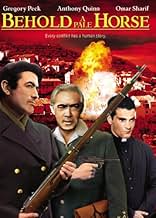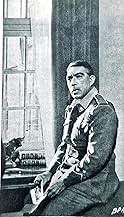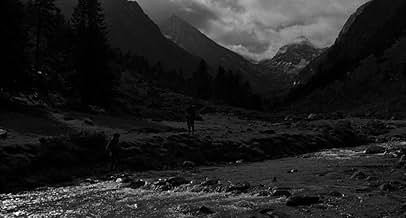IMDb-BEWERTUNG
6,7/10
2363
IHRE BEWERTUNG
Der berühmte spanische Bandit Artiguez kehrt nach 20 Jahren im französischen Exil in sein spanisches Heimatdorf zurück, doch der spanische Polizist Vinolas stellt ihm eine Falle.Der berühmte spanische Bandit Artiguez kehrt nach 20 Jahren im französischen Exil in sein spanisches Heimatdorf zurück, doch der spanische Polizist Vinolas stellt ihm eine Falle.Der berühmte spanische Bandit Artiguez kehrt nach 20 Jahren im französischen Exil in sein spanisches Heimatdorf zurück, doch der spanische Polizist Vinolas stellt ihm eine Falle.
Marietto
- Paco Dages
- (as Marietto Angeletti)
Perrette Pradier
- Maria, Hussy
- (as Perette Pradier)
Handlung
WUSSTEST DU SCHON:
- WissenswertesThe movie was banned in Spain, which was still ruled by Generalisimo Francisco Franco, the fascist victor of the Spanish Civil War.
- PatzerIn the first 5 minutes of the movie it is supposed to be 1939 and the Loyalist (Republican) soldiers are crossing into exile on the French border. As they cross over they are turning in their guns and the first one to turn in his gun turns in a Soviet PPSh-41 sub-machine gun. The PPSh-41 was not developed until 1941.
- Crazy CreditsOpening credits - the first card shown contains the passage from Revelations 6:8, which contains the phrase "Behold a Pale Horse", the title of the film.
- VerbindungenFeatured in Hollywood contra Franco (2008)
Ausgewählte Rezension
There have not been many English-language movies made about the Spanish Civil War, and those that have been made (with the exception of Land and Freedom) tend to shy away from both politics and action, often slow-moving, contemplative affairs. In that vein Behold a Pale Horse, based on a novel by Hungarian screenwriter Emeric Pressburger, is a meditation on loyalty, trust and faith, not in religion but in religious institutions and individuals. The Spanish Civil War, or rather its aftermath, are the backdrop for these themes. But despite this ruminating premise the picture just about manages to save itself from terminal dullness.
A lot of this has to do with director Fred Zinnemann. Zinnemann was not exactly a dynamic director but he had a certain way of drawing us into a story and holding our interest. During the opening credits his camera tracks along a line of nameless faces, encouraging us to look over every line and notice every blink, introducing a quietly human picture. And yet he is also placing people within their context, showing young Paco dwarfed amid the houses of Pau, mirroring the mountains from which he has descended, or panning down from the figure of Christ to a reverent Anthony Quinn (shades here of Zinnemann's other Christian-themed pictures A Nun's Story and A Man for All Seasons). Above all Zinnemann is a master of tension without over-manipulation. Events seem to unfold in real-time, with a sprinkling of point-of-view shots to draw us into the unfolding action.
It is interesting to see Gregory Peck and Anthony Quinn playing the hero and villain. Both men are possessed of dark hair and sharp, stony features. Both have a stern bearing and charismatic presence. One can imagine them playing brothers; a good twin and a bad twin perhaps. They are both very good here, but the best performance I feel belongs to Omar Shariff, grappling with some kind of a conscience, refusing to make the meek priest into a stereotype. Italian character actor Paolo Stoppa, familiar from a lot of European co-productions, is very good too. Finally, watch out for a brief but typically mesmerising bit part by Rosalie Crutchley as Quinn's wife.
A strong cast and thoughtful direction are enough to keep this picture moving. Also of note is the Maurice Jarre score. This was by now an era in which you didn't have to have a blaring orchestral score (and thankfully those irritating free jazz scores of the late 50s were going out of style). Behold a Pale Horse features sparse and staccato Spanish guitar, fitting for both the location and the nervous and somewhat melancholic story. This is far from being a war movie, but it is a picture of great solemnity, atmosphere and touching humanity.
A lot of this has to do with director Fred Zinnemann. Zinnemann was not exactly a dynamic director but he had a certain way of drawing us into a story and holding our interest. During the opening credits his camera tracks along a line of nameless faces, encouraging us to look over every line and notice every blink, introducing a quietly human picture. And yet he is also placing people within their context, showing young Paco dwarfed amid the houses of Pau, mirroring the mountains from which he has descended, or panning down from the figure of Christ to a reverent Anthony Quinn (shades here of Zinnemann's other Christian-themed pictures A Nun's Story and A Man for All Seasons). Above all Zinnemann is a master of tension without over-manipulation. Events seem to unfold in real-time, with a sprinkling of point-of-view shots to draw us into the unfolding action.
It is interesting to see Gregory Peck and Anthony Quinn playing the hero and villain. Both men are possessed of dark hair and sharp, stony features. Both have a stern bearing and charismatic presence. One can imagine them playing brothers; a good twin and a bad twin perhaps. They are both very good here, but the best performance I feel belongs to Omar Shariff, grappling with some kind of a conscience, refusing to make the meek priest into a stereotype. Italian character actor Paolo Stoppa, familiar from a lot of European co-productions, is very good too. Finally, watch out for a brief but typically mesmerising bit part by Rosalie Crutchley as Quinn's wife.
A strong cast and thoughtful direction are enough to keep this picture moving. Also of note is the Maurice Jarre score. This was by now an era in which you didn't have to have a blaring orchestral score (and thankfully those irritating free jazz scores of the late 50s were going out of style). Behold a Pale Horse features sparse and staccato Spanish guitar, fitting for both the location and the nervous and somewhat melancholic story. This is far from being a war movie, but it is a picture of great solemnity, atmosphere and touching humanity.
Top-Auswahl
Melde dich zum Bewerten an und greife auf die Watchlist für personalisierte Empfehlungen zu.
- How long is Behold a Pale Horse?Powered by Alexa
Details
Box Office
- Budget
- 3.900.000 $ (geschätzt)
- Laufzeit1 Stunde 58 Minuten
- Farbe
- Sound-Mix
- Seitenverhältnis
- 1.85 : 1
Zu dieser Seite beitragen
Bearbeitung vorschlagen oder fehlenden Inhalt hinzufügen

Oberste Lücke
By what name was Deine Zeit ist um (1964) officially released in India in English?
Antwort



































